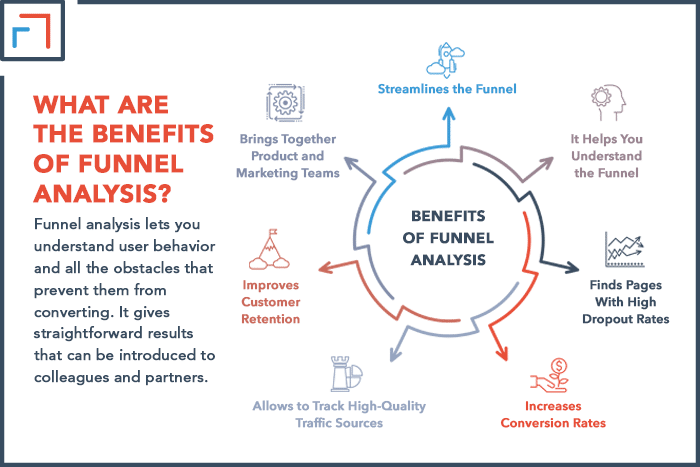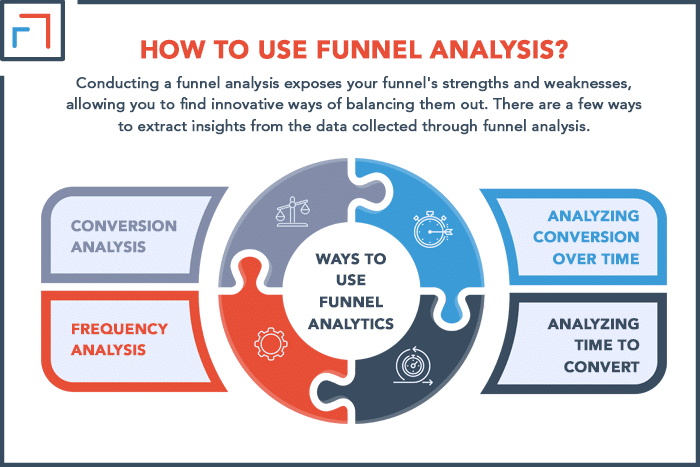Funnel analysis is the process of mapping out your visitors’ steps as they move through your sales funnel. Businesses use this information to optimize their funnels and improve their conversion rates.
Funnel analysis is important because it helps you understand your funnel. It allows you to monitor your users’ behavior at each stage of the funnel. You can track the sources with high-quality traffic and the pages with high dropout rates. It also helps streamline your funnel and retain customers.
Building a good funnel is the first step, but it’s important to track its performance so you can improve it as you go. This article will focus on the benefits of funnel analysis. Read on to learn how to use funnel analytics to improve your business.
What Are the Benefits of Funnel Analysis?
Funnel analysis is a valuable part of marketing. It’s used to observe the sequence of events that leads to a conversion. It shows how your users interact with your funnel and the steps they take before they convert or drop out.
Funnel analysis lets you understand user behavior and all the obstacles that prevent them from converting.
This is important because that behavior reveals their intentions and motivation.
It also allows you to test your funnel’s effectiveness and gives you a chance to identify and fix the weak points.
In addition, funnel analysis gives straightforward results that can be introduced to colleagues and different partners.
Good data is important in a business setting. You want to be able to present your findings in a clear, objective way.
This then makes it possible for everyone working on the funnel to come up with good solutions.
Here are a few other benefits of funnel analysis:
1. Streamlines the Funnel
Your company is probably made up of different points of interaction (email, dashboards, websites, mobile apps, etc).
In many cases, each point has a funnel of its own. But together, they represent a customer’s journey towards conversion.
Therefore, a funnel analysis shows a macro perspective of these funnels and how they link together.
2. It Helps You Understand the Funnel
You can easily manage different aspects of the funnel after carrying out funnel analysis.
However, by handling multiple things at once, you might be interrupting the most compelling steps. In turn, this might reduce your conversion rate.
By performing a funnel analysis, you can understand your funnel and what you need to prioritize when working through it.
3. Finds Pages With High Dropout Rates
A funnel analysis tool shows you both the conversion and dropout rates on all your pages.
This helps you understand when and where your users are dropping out of your funnel.
Identifying the pages with the highest dropout rates will help you optimize the funnel and increase your traffic.
4. Increases Conversion Rates
Conversion funnels can be customized for a variety of goals and outcomes.
The final step in the funnel might be to get a user to buy a product, download a PDF, or even click a signup button.
However, sometimes your users might leave the funnel before they reach that step.
Conversion funnel analysis allows you to find out what’s preventing your users from converting. Once you know, you can fix it.
Removing hindrances smooths out the funnel experience, and gets more people to the final step. This increases your conversion rates.
5. Allows You to Track High-Quality Traffic Sources
Since the first stage of a sales funnel is awareness, it’s important to know which source is bringing the most visitors into the funnel.
Most funnels have different entry points including blogs, social media posts, and infographics.
Funnel analysis helps you track the entry points of users. It shows which users joined the funnel and at what point.
Therefore, you can track which source brings in the most conversion and focus on it.
You can also see which sources are not creating enough awareness and decide whether to work on them or redirect your efforts to the more successful sources.
6. Improves Customer Retention
Funnel analysis is not only used in marketing and sales to improve prospective customers. It is also used to improve the existing customers’ experience.
Once you observe what your customers need, you can inject more value into the funnel steps and improve the experience for users within the funnel.
7. Brings Together Product and Marketing Teams
Marketing teams typically try to convert prospects into customers, while product teams aim to retain those customers through quality products.
With funnel analysis, these two teams can share data and insights.
Prospects who respond positively to a product in the product funnel are more likely to remain loyal to it in the marketing funnel.

How to Use Funnel Analysis?
In most cases, problems in your funnel need to be approached from a unique perspective.
Conducting a funnel analysis exposes your funnel’s strengths and weaknesses, allowing you to find innovative ways of balancing them out.
There are a few ways to extract insights from the data collected through funnel analysis.
How the data is interpreted and applied is pivotal to achieving your intended goals. Here are four ways to use funnel analytics:
1. Conversion Analysis
This is the standard way of analyzing funnels. It focuses on how the users convert.
Conversion funnel analysis measures the number of users who convert at each of the funnel’s steps. On most platforms, this data is represented visually in a graph or chart.
With this method of funnel analysis, you can tell immediately if there’s a problem. You’ll see a sharp drop in users during a given stage, so you know where to focus your efforts.
2. Analyzing the Conversion Over Time
You can use this type of analysis to see the rate of users who join the funnel at a specific date or time.
Users do not need to convert to appear in your conversion over time analysis.
This is crucial if you want to understand how your funnel operates during certain seasons such as during special events or holidays.
3. Analyzing Time to Convert
In analyzing funnels, it is important to consider the time factor. Using time to convert analysis, you can monitor how long it takes each user to click through the steps.
Observing these behaviors can confirm whether your funnel sequences are working as intended.
For example, a person shopping on a restaurant app should follow the funnel steps faster than someone on a tax service app.
When you analyze conversion on a weekly, daily, and hourly basis, you can alter the funnel’s flow to positively impact your business.
4. Frequency Analysis
Using this type of analysis, you can determine how many times users repeat a behavior before moving to the next step of the funnel.
When you analyze the frequency of users’ actions, you can see what they are doing throughout the funnel.
By watching the frequency of these events, you can make improvements to some funnel steps to encourage conversions.

Final Thoughts
Funnel analysis is an important marketing tool for any business. Conversion analysis allows you to see where the majority of your users convert.
With this information, you can elevate that page closer to the top of the funnel to make it visible to prospects who drop out early.
Analysis also shows you the pages with high dropout rates, allowing you to work on them or move them further down the funnel.
Finally, observing customer behavior on the funnel gives your product team some data and insights about what your users are interested in.
They can use this information to improve the product or change the undesirable aspects.
